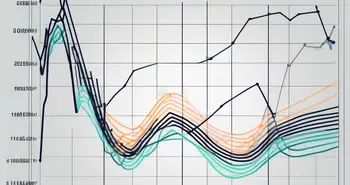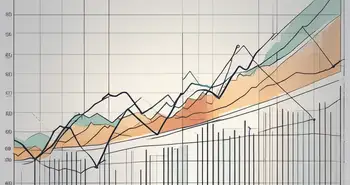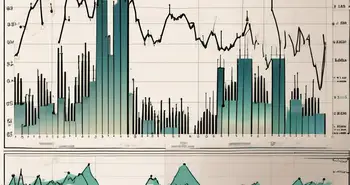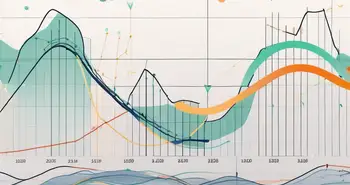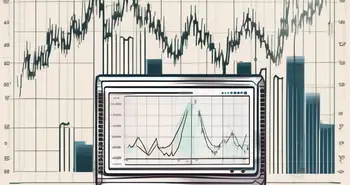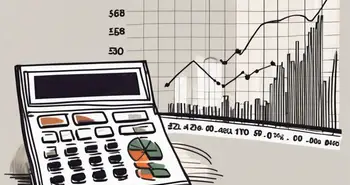How to Calculate Simple Moving Average
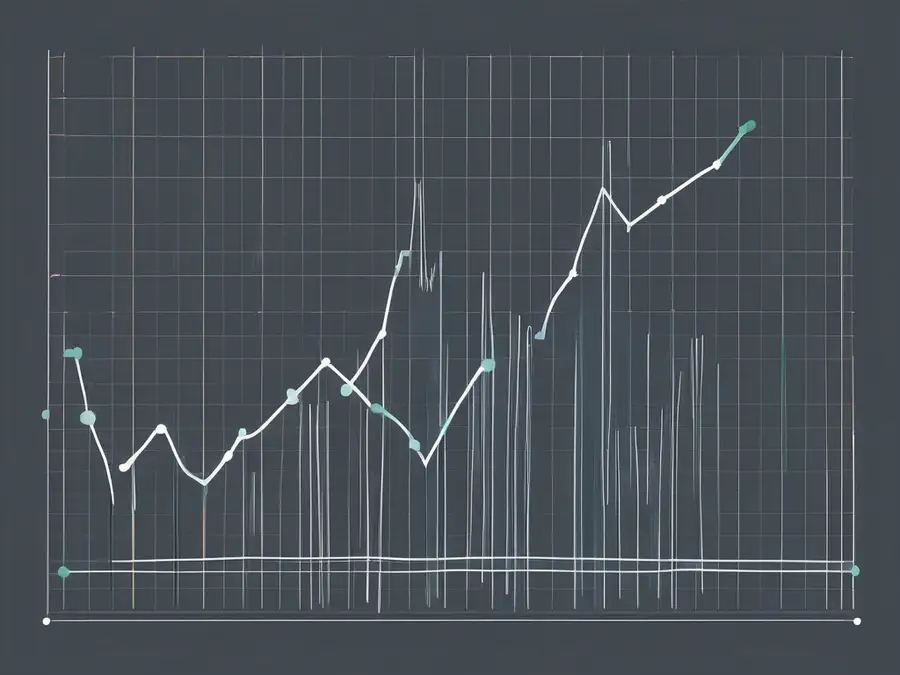
As a trading expert, I understand the importance of using technical analysis tools to make informed decisions. One such tool that is widely utilized by traders is the Simple Moving Average (SMA). In this comprehensive guide, I will walk you through the process of calculating the SMA step-by-step, explaining its concept, benefits, limitations, and practical applications.
Understanding the Concept of Simple Moving Average
Before delving into the calculation process, it's crucial to grasp the concept of the Simple Moving Average. The SMA is a mathematical calculation that helps identify trends and smooth out price fluctuations over a specific period of time. It serves as a lagging indicator, providing valuable insights into the overall direction of the market.
The Importance of Simple Moving Average in Trading
The SMA is a vital tool for traders, as it helps gauge the market sentiment and make more informed trading decisions. By analyzing price movements over a defined period, it allows traders to identify potential entry or exit points and assess the strength of a trend. Its simplicity and ease of use make it popular among both beginners and seasoned traders alike.
Basic Principles of Simple Moving Average
Before jumping into the calculation process, let's consider the fundamental principles of the Simple Moving Average. The SMA is calculated by taking the average of a specified number of closing prices over a defined period. This ‘moving' average continually updates as new data is added, providing a dynamic snapshot of the market.
Preparing Your Data for Calculation
Now that you understand the concept of SMA, it's time to prepare your data for the calculation process. Gathering relevant data involves selecting the desired timeframe and obtaining the historical prices of the asset you're analyzing.
Gathering Relevant Data
To calculate the SMA, you will need to gather the closing prices of the asset over the desired period. This data can usually be obtained from financial websites, trading platforms, or market data providers. Ensure the data is accurate and reliable, as any inconsistencies may lead to incorrect calculations and erroneous interpretations.
Organizing Your Data
Once you have obtained the closing prices, it's essential to organize the data in a logical and structured manner. Create a table or spreadsheet with two columns: date and closing price. Arrange the data in chronological order, starting from the earliest date to the most recent. This organized setup will facilitate the calculation process.
The Calculation Process of Simple Moving Average
Now that your data is ready, let's dive into the calculation process of the Simple Moving Average. By breaking down the steps and providing some useful tips, you'll be able to calculate the SMA with accuracy and confidence.
Breaking Down the Calculation Steps
To calculate the SMA, follow these steps:
- Select the desired period for the SMA, e.g., 10 days.
- Sum up the closing prices for the specified number of periods.
- Divide the total sum by the number of periods to obtain the average.
For example, if you are calculating the 10-day SMA, add up the closing prices for the last 10 days and divide the sum by 10. Repeat this process for each subsequent period to acquire a moving average line that reflects the overall trend.
Tips for Accurate Calculation
Here are some tips to ensure accurate SMA calculations:
- Avoid selecting too short or too long of a period. The length of the period should match your trading strategy and time horizon.
- Regularly update the calculations by incorporating new data points as they become available. This allows the SMA to reflect the most recent price movements.
- Double-check your calculations and ensure there are no errors in the data input or mathematical calculations. Even a minor mistake can lead to substantial variations in the results.
By adhering to these tips, you can minimize errors and obtain reliable SMA values that accurately reflect the market's movements.
Interpreting the Results of Simple Moving Average
Once you have calculated the SMA, understanding how to interpret the results is crucial for making effective trading decisions. Let's explore how to read the Simple Moving Average and highlight common mistakes to avoid.
How to Read Simple Moving Average
The Simple Moving Average provides valuable insights into the overall trend of an asset. When the price is above the SMA, it indicates an uptrend, while a price below the SMA suggests a downtrend. Additionally, the angle and slope of the SMA can provide further clues about the strength and momentum of the trend.
Common Mistakes in Interpretation
While the SMA is a powerful tool, it's essential to be aware of common mistakes in interpretation. Some common pitfalls to avoid include:
- Relying solely on the SMA without considering other technical indicators or fundamental factors.
- Using the SMA as a standalone tool without incorporating it into a comprehensive trading strategy.
- Overlooking the importance of risk management and stop-loss orders when relying on the SMA for trade entries or exits.
By avoiding these mistakes and combining the SMA with other analytical tools, you can enhance your trading decisions and increase your chances of success.
Applying Simple Moving Average in Real Trading
Now that you have a solid understanding of the SMA, let's explore how and when to apply it in real trading scenarios. By incorporating the SMA into your trading strategy, you can identify potential opportunities and improve your overall trading performance.
When to Use Simple Moving Average
The SMA can be utilized in various ways, depending on your trading style and objectives. Here are a few common scenarios where the SMA can prove beneficial:
- Identifying the overall trend: The SMA helps determine the direction of the market, enabling you to align your trades with the prevailing trend.
- Generating trade signals: Certain SMA crossovers, such as the 50-day and 200-day SMA, are popular indicators for triggering buy or sell signals.
- Support and resistance levels: The SMA can act as a dynamic support or resistance level, highlighting areas of potential reversals or breakouts.
By understanding when and how to use the SMA, you can harness its power to improve your trading decisions and potentially enhance your profitability.
Limitations of Simple Moving Average
While the SMA is a valuable tool, it's crucial to recognize its limitations to avoid potential pitfalls. Some limitations to consider include:
- Lagging indicator: The SMA relies on historical data, which means it may not respond quickly to sudden price spikes or reversals.
- Equal weighting: The SMA treats all periods equally, potentially smoothing out significant price movements and obscuring short-term fluctuations.
- False signals: Like any technical indicator, the SMA is not foolproof and can generate false signals, especially in choppy or sideways markets.
By acknowledging these limitations, you can use the SMA more effectively and supplement its analysis with other indicators to improve your trading decisions.
As an expert in the field of trading, I have personally witnessed the power of the Simple Moving Average in guiding trading strategies. I recall a time when I was analyzing a particular stock, and its 50-day SMA crossed above the 200-day SMA, indicating a potential bullish trend. I decided to go long on the stock and watched as it steadily climbed, resulting in a significant profit. This experience solidified my trust in the SMA as a reliable tool for identifying lucrative trading opportunities.
FAQs (Frequently Asked Questions)
Now, let's revisit some of the main points covered in this guide by addressing frequently asked questions:
Q: What is the Simple Moving Average (SMA)?
A: The SMA is a mathematical calculation that helps identify trends and smooth out price fluctuations over a specific period of time. It is widely used by traders to gain insights into the overall market direction.
Q: How do I calculate the Simple Moving Average?
A: To calculate the SMA, sum up the closing prices for your desired number of periods and divide the total by the number of periods. This process provides you with the average price over that specific timeframe.
Q: How can I interpret the Simple Moving Average results?
A: When the price is above the SMA, it suggests an uptrend, while a price below the SMA indicates a downtrend. Additionally, the angle and slope of the SMA can provide insights into the strength and momentum of the trend.
Q: Should I solely rely on the Simple Moving Average for my trading decisions?
A: While the SMA is a valuable tool, it should be used in conjunction with other technical indicators and fundamental factors. Consider developing a comprehensive trading strategy that incorporates multiple tools and risk management techniques.
Q: Can the Simple Moving Average be applied to different financial instruments?
A: Yes, the SMA can be applied to various financial instruments, including stocks, commodities, forex, and cryptocurrencies. However, it's essential to adjust the calculation parameters based on the characteristics of each instrument.
By following this step-by-step guide and understanding the nuances of the Simple Moving Average, you are well-equipped to enhance your trading analysis and decision-making process. Remember, practice and experience are key to mastering any technical analysis tool, and the SMA is no exception. Happy trading!
Ready to put your newfound knowledge of the Simple Moving Average to the test in live markets? Look no further than Morpher, the innovative trading platform that's changing the game with blockchain technology. Experience zero fees, infinite liquidity, and the freedom to trade a variety of asset classes, from stocks to the most unconventional markets. Whether you're looking to invest fractionally, short sell without interest fees, or leverage your trades up to 10x, Morpher empowers you with the tools you need for a unique and advanced trading experience. Take control of your investments with the safety and flexibility of the Morpher Wallet. Sign Up and Get Your Free Sign Up Bonus today, and elevate your trading to the next level with Morpher.

Disclaimer: All investments involve risk, and the past performance of a security, industry, sector, market, financial product, trading strategy, or individual’s trading does not guarantee future results or returns. Investors are fully responsible for any investment decisions they make. Such decisions should be based solely on an evaluation of their financial circumstances, investment objectives, risk tolerance, and liquidity needs. This post does not constitute investment advice.

Painless trading for everyone
Hundreds of markets all in one place - Apple, Bitcoin, Gold, Watches, NFTs, Sneakers and so much more.

Painless trading for everyone
Hundreds of markets all in one place - Apple, Bitcoin, Gold, Watches, NFTs, Sneakers and so much more.

